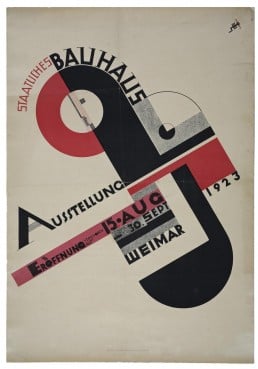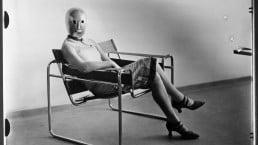
"Together let us desire, conceive, and create the new structure of the future, which will embrace architecture and sculpture and painting in one unity and which will one day rise toward Heaven from the hands of a million workers like the crystal symbol of a new faith" Walter Gropius, Founder of the Bauhaus
Bauhaus 100
On April 1 1919, Walter Gropius founded the Bauhaus in Weimar, Germany. 2019 marks the centenary of the Bauhaus movement, which is celebrated all year long under the title Bauhaus 100. Though the movement is celebrated with exhibitions and events worldwide, the main events are taking place throughout Germany. We will take you through the history of Bauhaus and guide you to the best exhibitions and events on offer in 2019.
A Brief History of Bauhaus
The founding of Bauhaus
In Berlin of 1919, Berlin-born architect Walter Gropius founded the Bauhaus in Weimar. He intended it as an interdisciplinary school of design with an international outlook. The idea was to bring together artistically gifted students and to merge art, architecture and craftsmanship. The Bauhaus students were taught to work with materials through innovative and experimental methods. Each discipline had its own workshop, and each workshop had its own master of works and master of form. The master of works was responsible for craftsmanship and technical matters, while the master of form took charge of aesthetics. Walter Gropius employed many acclaimed artists of the time as professors, including the likes of Johannes Itten, Lyonel Feininger, Gerhard Marcks, Paul Klee, Oskar Schlemmer, Wassily Kandinsky and Laszlo Moholy-Nagy. Thus, Bauhaus Weimar became the meeting point for the international avant-garde.
From Weimar to Dessau
In 1925, the Bauhaus left Weimar due to financial issues of political origin, and relocated to Dessau. This up-and-coming industrial town was attractive to the Bauhaus due to the prospect of collaboration with the local industries. Here, the focus became more and more on the development of well-designed everyday products. During this period, some of the most well known Bauhaus buildings and products were created. Moreover, the complex where the artist masters lived became one of the most important artist colonies of the modern era.
Political tension
Yet, as the radical right wing started to gain more traction in politics, the Bauhaus started to experience increasing hostility. In the face of this, Walter Gropius stepped down as director in 1928 and appointed Hannes Meyer in his stead. Under Meyer’s leadership, the Bauhaus focused on science and the creation of affordable, well-designed products and buildings. In 1930, Meyer was forced out following allegations that he was responsible for the communist engagements of his students. Gropius then recommended architect Ludwig Mies van der Rohe as the new director. Van der Rohe was interested only in architecture and its aesthetic, and therefore reshifted the focus completely to contemporary architecture. Despite all the changes and the decrease in political nature at the Bauhaus school, it was forced to close in 1932 by Dessau city council’s National Socialist majority.
The end of Bauhaus
Still, there was no getting rid of the Bauhaus. For one semester, Van der Rohe even tried to keep the school going in an old Berlin-Steglitz telephone factory. However, the National Socialists put a final end to it in 1933 when they sealed off the factory building, stopped paying the staff and ended the tenant agreement. Yet the ideas of the Bauhaus lived on and were spread around the world by its artists and students, not least by Moholy-Nagy, who even founded a new iteration of the Bauhaus in Chicago in 1937.
Bauhaus 100 – The Centenary
2019 is the year of Bauhaus 100, the 100 year anniversary of the Bauhaus. All over the world (with the most events in Germany), the influential movement is being celebrated. What makes the Bauhaus so relevant today is the fact that it was so diverse and heterogeneous. Its focus was creating an interdisciplinary, international hub where individuals could explore cutting-edge methods and ideas through an open-minded approach.
Countless exhibitions and events this year echo the core values and approaches of the Bauhaus. At times these are glances back through its history, at other times they are examinations of the movement’s influence in contemporary society. To help you navigate the countless exhibitions and events during Bauhaus100, we have created a list of 10 exhibition highlights. These exhibitions are currently on or will soon be on view. Read on to discover where to catch the best of Bauhaus this year.



1. Original Bauhaus
Our first pick during Bauhaus 100 is ‘Original Bauhaus’. By examining 14 objects, this exhibition will develop 14 case histories of the Bauhaus legacy. For example, how did the woman sitting on the famous tubular-steel chair become the most famous anonymous Bauhaus figure? ‘Original Bauhaus’ sheds light on the inseparable links between unique work and series, remake and original in the Bauhaus movement.
When?
06.09.2019 – 27.01.2019
Where?
Bauhaus-Archiv/Museum für Gestaltung in cooperation with the Berlinische Galerie
2. Bauhaus Museum Weimar
The recently opened Bauhaus Museum in Weimar was designed by German architect Heike Hanada. This minimalist concrete museum is located near the Nazi-era Gauforum square and the Neue Museum Weimar. It contains 2,000 square metres of exhibitions space and displays around 1,000 items from the Weimar Bauhaus collection.
When? Open since 06.04.2019
Where? Weimar, Germany
Learn more here
3. Festival Architecture Radical
The Bauhaus buildings in Dessau were radical designs for the future. The Festival Architecture Radical explores to what extent architectural radicalism is still topical today. For three days, the Open Stage at the Dessau Bauhaus Museum and the Employment Office designed by Walter Gropius will function as the festival headquarters. There will be workshops, conferences and temporary installations. Public Radical Tours will be held through the Bauhaus buildings and the city centre on June 1st and 2nd.
When? 31.05.2019 – 02.06.2019
Where? Dessau-Rosslau, Amt für öffentliche Sicherheit und Ordnung
4. Oskar Schlemmer – The Bauhaus and the path to modernity
Oskar Schlemmer was perhaps one of the most versatile Bauhaus artists. He worked as a painter, draughtsman, graphic artist, sculptor, stage designer, muralist, choreographer and writer. He strived for a future in which modern human beings would live in harmony with technical and social innovation. This exhibition will be the first monographic exhibition of Schlemmer’s works in the new German federal states. The exhibition will focus on his work from the 1920s and 1930s.
When? 28.04.2019 – 28.07.2019
Where? Gotha, Herzogliches Museum
Learn more here
5. Bauhaus Imaginista
Bauhaus Imaginista tells the transnational story of the Bauhaus, examining its reception in Asia, Africa and the Americas. The exhibition brings together material from exhibitions, symposia and workshops in Hangzhou, Kyoto, Tokyo, Sao Paolo, Lagos, Delhi, New York and Moscow in 2018. A unique opportunity to learn about the complete international impact and development of the Bauhaus movement.
When? 15.03.2019 – 10.06.2019
Where? Berlin, Haus der Kulturen der Welt
Learn more here
6. Heimo Zobernig: Piet Mondrian
Since the mid-80s, Heimo Zobernig has been investigating the design of spaces and the presentations of art. In particular, he has focused on the abstractions of Piet Mondrian. For this exhibition, Zobernig has developed a new installation for the atrium at the Albertinum, interpreting one of Mondrian’s unrealised designs from 1926. Meanwhile, artists Céline Condorelli, Kapwani Kiwanga and Judy Radul are invited to perform artistic interventions in the museum collection. Parallel to these projects is the exhibition ‘Visionary Spaces. KANDINSKY, MONDRIAN, LISSITZKY and the Abstract-Constructivist Avant-Garde in Dresden 1919 – 1932’.
When? 02.03.2019 – 02.06.2019
Where? Dresden, Albertinum, Staatliche Kunstsammlungen Dresden
7. Between Utopia and Adaptation – The Bauhaus in Oldenburg
Between 1923 and 1927 Hans Martin Fricke, Hermann Gautel, Karl Schwoon and Hin Bredendieck, four young men from Oldenburg and East Frisia, studied at the Bauhaus. ‘Between Utopia and Adaptation – The Bauhaus in Oldenburg’ explores the biographies and works of these four Bauhaus students. By delving into the history and practice of these young men, the impact of the Bauhaus style is re-examined.
When? 27.04.2019 – 04.08.2019
Where? Oldenburg, Landesmuseum für Kunst und Kulturgeschichte
8. Intermedial Bauhaus Experiments. Kurt Schmidt and the Synthesis of Arts
This exhibition focuses on the works of Bauhaus artist Kurt Schmidt. The artist experimented a great deal with colours, forms and abstract objects before finding his personal image language. He subsequently worked a great deal at the intersection of music, theatre, dance and fine arts. His 1923 “Mechanical Ballet” became one of the most revolutionary plays of the 20th century. The main idea behind the piece was to visualise the dynamic forces of abstract images and generate paintings in motion. Other artists featured in the exhibition are Vikking Eggeling, Ludwig Hirschfeld-Mack, Johannes Itten, Wassily Kandinsky, Paul Klee, László Moholy-Nagy, Hans Richter, Oskar Schlemmer, Kurt Schwerdtfeger and Andreas Weininger.
When? 23.03.2019 – 09.06.2019
Where? Kunstsammlung Gera, Orangerie
9. Weissenhof City – The History and Present of the Future of a City
Staatsgalerie Stuttgart has invited artists Dani Gal, Michaela Melián, Martin Schmidl and Boris Sieverts to produce site-specific works investigating the people, ideas, impact and reception of the Bauhaus and Modernism in Stuttgart. The works range from videos and installations to walking tours through Stuttgart.
When? 07.06.2019 – 20.10.2019
Where? Staatsgalerie Stuttgart
10. Bauhaus and Photography – On Neues Sehen in Contemporary Art
This exhibition explores Bauhaus photography and opens up a dialogue between the photographic avant-garde of the 1930s and contemporary photography. Works by artists such as László Moholy-Nagy, Lucia Moholy, Man Ray, Jan Tschichold, Hedda Walther, Florence Henri, Hans Robertson and Erich Consemüller are juxtaposed with works by Thomas Ruff, Dominique Teufen, Daniel T. Braun, Wolfgang Tillmans, Doug Fogelson, Max de Esteban, Viviane Sassen, Stephanie Seufert, Kris Scholz, Taiyo Onorato & Nico Krebs, Antje Hanebeck and Douglas Gordon.
When? 11.04.2019 – 25.08.2019
Where? Helmut Newton Foundation/Museum of Photography, Berlin
